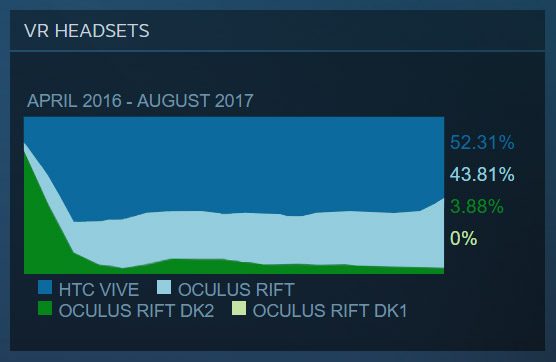According to the latest figures from Valve’s Hardware & Software Survey, the Oculus Rift has set a new record for its highest historical market share on Steam, almost certainly driven by a major sale which has also brought the headset its largest ever share increase from one month to the next. While the HTC Vive continues to hold the majority share, the Rift is approaching striking distance.
Steam is the de facto content platform for the HTC Vive though it technically supports the Rift too; plenty of Rifters use both the official Oculus Home platform and Steam to play content which may not be available on the opposing platform.
Each month, Valve runs a survey among Steam users to determine some baseline statistics about what kind of hardware and software is used by the user population, and to see how things are changing over time; that includes which VR headsets are connected to users’ computers.
The latest results show a major gain of 8.1% in the Rift’s share of VR headsets on Steam, bringing the device’s overall share to its highest point ever, reaching 43.8% of all headsets in use on the platform.
The gain was made up mostly by a 7.7% reduction in Vive share and the remaining 0.4% from a reduction in the Rift DK2 development kit. The latter, launched in 2014, still holds 3.9% total share of VR headsets in use on Steam. With Steam as its primary content platform, the Vive naturally holds onto the majority share at 52.3% of all VR headsets on the platform, though at 43.8%, the Rift is approaching striking distance.


Exactly how many Rift users use Steam among the total population of Rift users is unknown, making it largely futile to extrapolate the data in an effort to determine headset market share across all platforms. However, many analyst estimates put the Vive ahead of the Rift in total sales.
The 8.1% gain, the largest ever for the Rift on Steam, was almost certainly driven by the ‘Summer of Rift’ sale which reduced the price of the Rift & Touch controllers from $600 to $400. When the sale ends after September 4th, the non-sale price for a new all-in-one Rift & Touch bundle will be $500. A portion of the gains may have been made up not by new headsets entering the market, but by more Rift users becoming aware of Steam’s compatibility with the Rift. Another contributor could be the expansion of HTC’s Viveport app store and the Viveport subscription service, potentially drawing some Vive users away from Steam.
While the Rift has enjoyed significant buzz surrounding its lengthy sale, HTC recently brought a major price cut to Vive, setting its new baseline price at $600 (previously $800). HTC said the price cut was not a reaction to the Rift sale.
While the Rift and Vive fight it out on Steam, new competitors are soon to complicate the binary battle. The Windows VR headsets are due to launch starting in October at $400, and Microsoft has confirmed that they’ll be compatible with SteamVR content.


